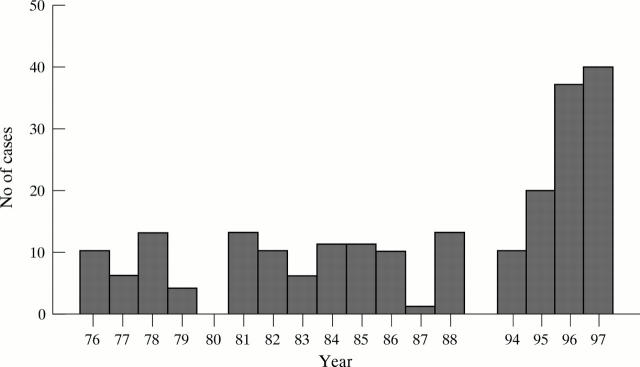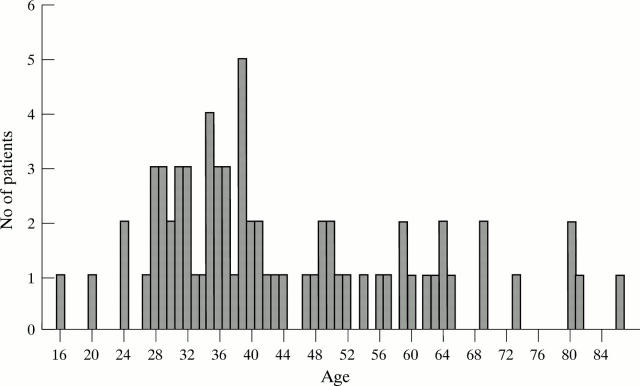Abstract
AIMS—To assess changes in incidence of conjunctival squamous cell carcinoma over a 22 year period in Tanzania and to analyse possible reasons for change. METHODS—Retrospective analysis of records from a Tanzanian pathology department serving north and central Tanzania from 1976 to 1997; medical record analysis of cases of conjunctival squamous cell carcinoma presenting in the last 2 years of the study. RESULTS—There was a sharp rise in the incidence of conjunctival squamous cell carcinoma in the last 3 years of the study (1995-7). The mean age of patients presenting with the condition over the full period was 44.7 years (95% confidence interval 42.4-46.9 years). In the final 2 years of the study the mean length of history on presentation was 3.1 months (2.1-4.0 months). Several patients had a previous history of chronic conjunctival disease such as allergic conjunctivitis and trachoma; one had had a conjunctival papilloma excised previously. Only five patients had been tested for HIV status, but of these four were positive. CONCLUSION—Tanzania is experiencing an epidemic of conjunctival squamous cell carcinoma similar to that seen in other African countries. Often the tumours are aggressive and occur in patients of relatively young age. The epidemic appears to be related to HIV infection, on a background of ultraviolet light exposure. Previous chronic conjunctival disease and exposure to human papillomavirus may also have a role. Keywords: conjunctiva; squamous cell carcinoma; HIV
Full Text
The Full Text of this article is available as a PDF (68.8 KB).
Figure 1 .
Cases of conjunctival squamous cell carcinoma per year.
Figure 2 .
Age of patients with conjunctival squamous cell carcinoma in 1996 and 1997.
Selected References
These references are in PubMed. This may not be the complete list of references from this article.
- Ateenyi-Agaba C. Conjunctival squamous-cell carcinoma associated with HIV infection in Kampala, Uganda. Lancet. 1995 Mar 18;345(8951):695–696. doi: 10.1016/s0140-6736(95)90870-6. [DOI] [PubMed] [Google Scholar]
- Beadle P. C., Leach J. F. Holidays, ozone and skin cancer. Skin cancer in bristol--a comparison of theory with observation. Arch Dermatol Res. 1982;274(1-2):47–56. doi: 10.1007/BF00510357. [DOI] [PubMed] [Google Scholar]
- Kestelyn P., Stevens A. M., Ndayambaje A., Hanssens M., van de Perre P. HIV and conjunctival malignancies. Lancet. 1990 Jul 7;336(8706):51–52. doi: 10.1016/0140-6736(90)91562-o. [DOI] [PubMed] [Google Scholar]
- Lee G. A., Hirst L. W. Ocular surface squamous neoplasia. Surv Ophthalmol. 1995 May-Jun;39(6):429–450. doi: 10.1016/s0039-6257(05)80054-2. [DOI] [PubMed] [Google Scholar]
- McDonnell J. M., McDonnell P. J., Sun Y. Y. Human papillomavirus DNA in tissues and ocular surface swabs of patients with conjunctival epithelial neoplasia. Invest Ophthalmol Vis Sci. 1992 Jan;33(1):184–189. [PubMed] [Google Scholar]
- Waddell K. M., Lewallen S., Lucas S. B., Atenyi-Agaba C., Herrington C. S., Liomba G. Carcinoma of the conjunctiva and HIV infection in Uganda and Malawi. Br J Ophthalmol. 1996 Jun;80(6):503–508. doi: 10.1136/bjo.80.6.503. [DOI] [PMC free article] [PubMed] [Google Scholar]
- Wise J. HIV epidemic is far worse than thought. BMJ. 1997 Dec 6;315(7121):1486–1486. doi: 10.1136/bmj.315.7121.1485b. [DOI] [PMC free article] [PubMed] [Google Scholar]




